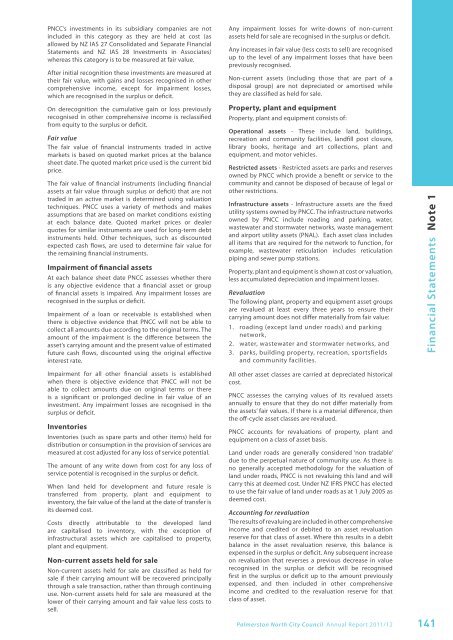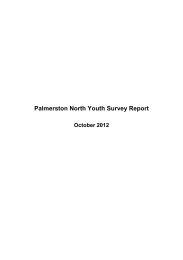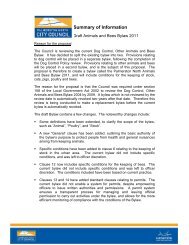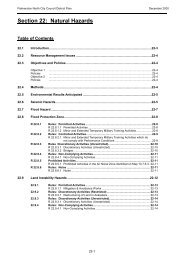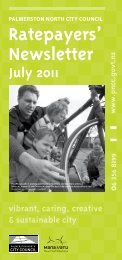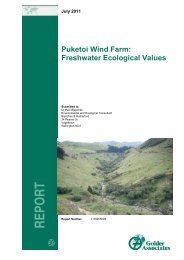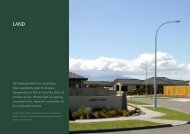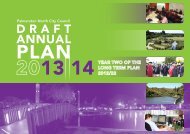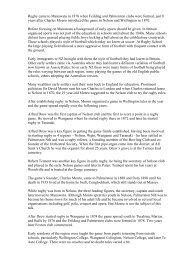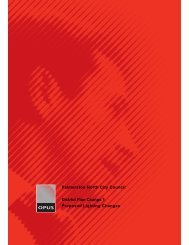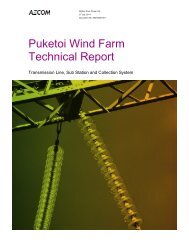2011-2012 Annual Report - Full Version - PDF - Palmerston North ...
2011-2012 Annual Report - Full Version - PDF - Palmerston North ...
2011-2012 Annual Report - Full Version - PDF - Palmerston North ...
- No tags were found...
Create successful ePaper yourself
Turn your PDF publications into a flip-book with our unique Google optimized e-Paper software.
PNCC’s investments in its subsidiary companies are notincluded in this category as they are held at cost (asallowed by NZ IAS 27 Consolidated and Separate FinancialStatements and NZ IAS 28 Investments in Associates)whereas this category is to be measured at fair value.After initial recognition these investments are measured attheir fair value, with gains and losses recognised in othercomprehensive income, except for impairment losses,which are recognised in the surplus or deficit.On derecognition the cumulative gain or loss previouslyrecognised in other comprehensive income is reclassifiedfrom equity to the surplus or deficit.Fair valueThe fair value of financial instruments traded in activemarkets is based on quoted market prices at the balancesheet date. The quoted market price used is the current bidprice.The fair value of financial instruments (including financialassets at fair value through surplus or deficit) that are nottraded in an active market is determined using valuationtechniques. PNCC uses a variety of methods and makesassumptions that are based on market conditions existingat each balance date. Quoted market prices or dealerquotes for similar instruments are used for long-term debtinstruments held. Other techniques, such as discountedexpected cash flows, are used to determine fair value forthe remaining financial instruments.Impairment of financial assetsAt each balance sheet date PNCC assesses whether thereis any objective evidence that a financial asset or groupof financial assets is impaired. Any impairment losses arerecognised in the surplus or deficit.Impairment of a loan or receivable is established whenthere is objective evidence that PNCC will not be able tocollect all amounts due according to the original terms. Theamount of the impairment is the difference between theasset’s carrying amount and the present value of estimatedfuture cash flows, discounted using the original effectiveinterest rate.Any impairment losses for write-downs of non-currentassets held for sale are recognised in the surplus or deficit.Any increases in fair value (less costs to sell) are recognisedup to the level of any impairment losses that have beenpreviously recognised.Non-current assets (including those that are part of adisposal group) are not depreciated or amortised whilethey are classified as held for sale.Property, plant and equipmentProperty, plant and equipment consists of:Operational assets - These include land, buildings,recreation and community facilities, landfill post closure,library books, heritage and art collections, plant andequipment, and motor vehicles.Restricted assets - Restricted assets are parks and reservesowned by PNCC which provide a benefit or service to thecommunity and cannot be disposed of because of legal orother restrictions.Infrastructure assets - Infrastructure assets are the fixedutility systems owned by PNCC. The infrastructure networksowned by PNCC include roading and parking, water,wastewater and stormwater networks, waste managementand airport utility assets (PNAL). Each asset class includesall items that are required for the network to function, forexample, wastewater reticulation includes reticulationpiping and sewer pump stations.Property, plant and equipment is shown at cost or valuation,less accumulated depreciation and impairment losses.RevaluationThe following plant, property and equipment asset groupsare revalued at least every three years to ensure theircarrying amount does not differ materially from fair value:1. roading (except land under roads) and parkingnetwork,2. water, wastewater and stormwater networks, and3. parks, building property, recreation, sportsfieldsand community facilities.Financial Statements Note 1Impairment for all other financial assets is establishedwhen there is objective evidence that PNCC will not beable to collect amounts due on original terms or thereis a significant or prolonged decline in fair value of aninvestment. Any impairment losses are recognised in thesurplus or deficit.InventoriesInventories (such as spare parts and other items) held fordistribution or consumption in the provision of services aremeasured at cost adjusted for any loss of service potential.The amount of any write down from cost for any loss ofservice potential is recognised in the surplus or deficit.When land held for development and future resale istransferred from property, plant and equipment toinventory, the fair value of the land at the date of transfer isits deemed cost.Costs directly attributable to the developed landare capitalised to inventory, with the exception ofinfrastructural assets which are capitalised to property,plant and equipment.Non-current assets held for saleNon-current assets held for sale are classified as held forsale if their carrying amount will be recovered principallythrough a sale transaction, rather than through continuinguse. Non-current assets held for sale are measured at thelower of their carrying amount and fair value less costs tosell.All other asset classes are carried at depreciated historicalcost.PNCC assesses the carrying values of its revalued assetsannually to ensure that they do not differ materially fromthe assets’ fair values. If there is a material difference, thenthe off-cycle asset classes are revalued.PNCC accounts for revaluations of property, plant andequipment on a class of asset basis.Land under roads are generally considered ‘non tradable’due to the perpetual nature of community use. As there isno generally accepted methodology for the valuation ofland under roads, PNCC is not revaluing this land and willcarry this at deemed cost. Under NZ IFRS PNCC has electedto use the fair value of land under roads as at 1 July 2005 asdeemed cost.Accounting for revaluationThe results of revaluing are included in other comprehensiveincome and credited or debited to an asset revaluationreserve for that class of asset. Where this results in a debitbalance in the asset revaluation reserve, this balance isexpensed in the surplus or deficit. Any subsequent increaseon revaluation that reverses a previous decrease in valuerecognised in the surplus or deficit will be recognisedfirst in the surplus or deficit up to the amount previouslyexpensed, and then included in other comprehensiveincome and credited to the revaluation reserve for thatclass of asset.<strong>Palmerston</strong> <strong>North</strong> City Council <strong>Annual</strong> <strong>Report</strong> <strong>2011</strong>/12141


